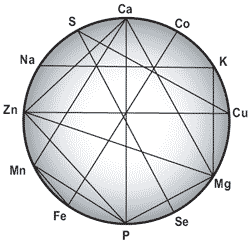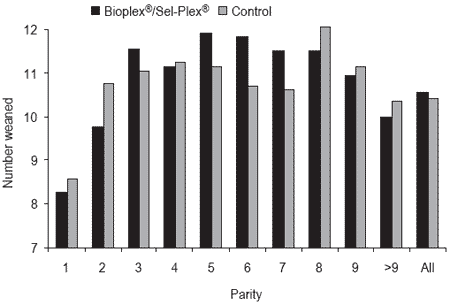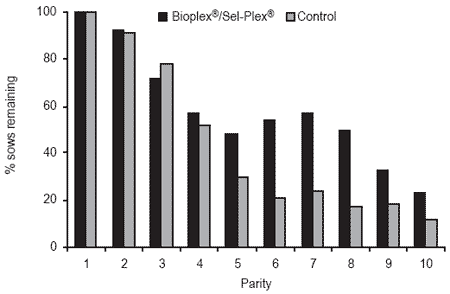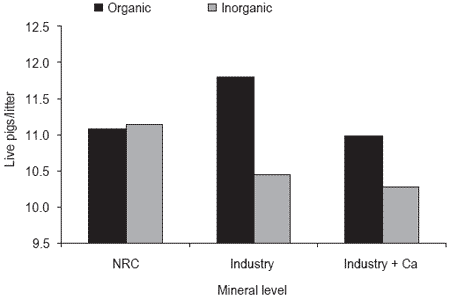Nutritional approaches to maximize fertility in modern pig genotypes
Advances in swine productivity through genetic selection, management, health and nutritional strategies have resulted in reproductive performance once unimaginable. Feed efficiencies during the growing and finishing phase of production have improved in the range of 25% over the past 15 years (Fremaut, 2003). Sow reproductive efficiency has shown equal improvement and the biological potential of today’s modern, hyperprolific genotypes is truly staggering (Close and Cole, 2001; Johnson, 2006; Shantz, 2006).
However, currently defined nutrient requirements are largely outdated as they are based on research conducted decades ago (NRC, 1998). Reviews on energy (Noblet, 2007) and amino acids (Close and Cole, 2001) have provided excellent updates on potential systems for dietary formulation for today’s modern genotypes. Mateos et al. (2005) provided an excellent review on the role and function of trace minerals in swine production, emphasizing the need for further research to more closely define the requirements of the hyperprolific sow.
Indeed, the question has been raised: “If a technology exists to improve reproductive performance, while maintaining or lowering cost of production and at the same time reducing the impact on the environment, are nutritionists not obligated to consider it?” This is a very timely question and one that should be seriously considered during diet formulations. Therefore, the purpose of this paper is to review the nutritional factors associated with the delivery of adequate nutrients to meet the ever increasing nutritional demands of modern genotypes with particular reference being made to new advances in nutritional supplementation.
Historical approaches to nutritional supplementation
Traditional dietary formulation has relied on the research-based requirements set forth by scientific collaborations such as NRC (1998) and ARC (1981). Also, detailed biological models have been developed to accurately estimate the amino acid and energy requirements of sows (Noblet et al., 1990; Pettigrew et al., 1992a,b; NRC, 1998). While these applications are accurate for the energy and amino acid component of sow nutrient requirements, very little research has focused on the trace mineral requirements of hyperprolific sows (Peters, 2006).
As illustrated in Table 1, the trace mineral recommendations vary considerably between industry and reference recommendations and many of these recommendations are based on research that is decades old (Table 2). So, the question could be asked “Has trace mineral nutrition kept up with genetic progress, and if not, what are the consequences?”
Table 1. Recommended trace mineral levels for lactating sows1.
1 Adapted from Mateos et al. (2005), all levels in mg/kg of complete feed
2 CFIA Table 4 (1983)
3 No requirement specified
4 Kansas State University
5 Nebraska and South Dakota State University
Table 2. Year of research used in estimate of trace mineral requirements in swine1.
1 Adapted from NRC (1998)
The role of trace minerals in sow and boar reproduction is extremely important and is detailed in Figure 1. Mahan and Newton (1995) clearly demonstrated that the draining effects of enhanced reproduction result in the depletion of sow body mineral reserves after three parities (Figure 2).
In working boars, although the impact of trace mineral supplementation and research is very limited (Mahan et al., 2002), current research findings are proving to be interesting and indicate that enhanced supplementation to working boars with organic trace minerals improves semen concentration and increases the number of doses of extended semen per ejaculate (Mahan et al., 2002; Groenewegen et al., 2006).
Unfortunately, dealing with today’s breeding stock of higher genetic potential does not simply allow nutritionists to continually supplement diets with higher levels of minerals due to the known interactions between the elements (Figure 3). In addition, environmental pressures exist to reduce heavy metals in effluent (Ferket et al., 2002), yet higher recommended levels may contribute unnecessarily to pollution.
Therefore, a more detailed approach to diet formulations must be undertaken to ensure the nutritional needs of the modern sow and boar are met allowing them to express their genetic potential while improving longevity and lifelong performance.

Figure 1. Potential roles of trace minerals in sow production (Close, 1999).
Figure 2. Sow body mineral compositional change at the end of a three-parity period compared to a non-gravid control (from Mahan and Newton, 1995).
New approaches to maximize productivity
The ultimate goal of nutritionists and producers alike is to maximize the number of healthy, top quality piglets from the sow that can then be reared to maximize meat production per sow per year at minimal cost (Close and Turnley, 2004). With this goal in mind, developing feeding strategies for the hyperprolific sow allows nutritionists to maintain a focused approach tending away from least cost formulation to formulations focusing on optimal costs and return over feed cost. During program development, the following objectives should be front and center:
Figure 3. Some important mineral interactions (adapted from Miller et al., 1979).
1. To maintain or improve reproductive performance
2. To maintain cost or reduce the cost of production
3. To reduce nutrient emissions in effluent to protect the environment
Keeping these objectives in mind, my journey in developing recommendations for the hyperprolific sow began in the area of production that results in the largest drain on the sow, namely lactation. Studies by Fehse and Close (2000) were among the first to show the impact of organic trace mineral supplementation on reproductive performance (Figure 4) and sow longevity (Figure 5). These data, coupled with the report of Mahan and Newton (1995), indicated a depletion of trace elements as sows age. Supplementation with organic trace minerals appeared to offer a solution due to their higher retention.
Figure 4. Effect of an organic trace mineral pak (Bioplexes® + Sel-Plex®) on sow productivity (from Fehse and Close, 2000).
Figure 5. Effect of an organic trace mineral supplement on sow longevity (from Fehse and Close, 2000).
Several studies have supplemented additional trace minerals ‘on top’ of the existing diet to elicit the reproductive response. However, this approach could potentially conflict with several of the objectives listed above. Keeping this in mind, the first diets to contain organic trace minerals in the form of Bioplex® (Alltech Inc.) and Sel-Plex® (Alltech Inc.) were lactation rations. Large nutrient drains occur during the late gestation and lactation periods of the reproductive cycle.
Before the increased feed intake seen during lactation, the final two weeks of gestation may potentially pose the largest drain on the sow, with over 50% of the mineral content of the foetal tissue being deposited during this time (Mahan, personal communication). Therefore, supplementing the lactation ration with organic trace minerals and feeding these diets pre-farrowing may be an excellent management technique to ensure maximum mineralization of the foetus while minimizing the drain on the sow.
Initial fortification of the lactation ration was based on a percentage replacement (Table 3). The base inorganic trace mineral was supplied as total added to the diet, not including that supplied by the remainder of the ingredients. This total formed the basis from which further recommendations were developed.
Preliminary observations from the field included reduced wean-to-oestrus interval, stronger heats and subsequently better structural conformation, and fewer feet and leg problems. In higher producing herds (>25 pigs/sow/year) a similar trace mineral package could be incorporated into gestation diets as the added benefit of incorporating Bioplex® and Sel-Plex® into the lactation diets is observed.
Incorporation of Bioplex® and Sel-Plex® has subsequently been amended to provide an absolute amount of trace mineral in the diets of lactation and gestation sows, compared with a percentage replacement, since there may be industry and regional differences in the levels of absolute trace minerals added. Table 4 illustrates the recommended Bioplex® and Sel-Plex® supplementation level for hyperprolific sows.
Current research findings using similar supplementation levels were reported by Lima et al. (2006) who reported significant improvements in live births, litter size at weaning and reduced stillbirths.
Recent research findings by Peters (2006) demonstrated that the level and source of trace mineral supplementation affects sow reproductive performance. Over a six parity period, utilizing 375 litters, Peters (2006) found that increasing the dietary trace mineral level improved performance when Bioplex® and Sel-Plex® forms of the trace minerals were fed, whereas increasing the levels using sulphate minerals reduced performance (Figure 6).
The supplementation of organic trace minerals in this trial resulted in 1 extra pig per litter (>2.2 pigs/sow/year) when trace minerals were fed at typical industry levels compared with the NRC (1998) recommended levels. Likewise, sow and piglet body mineral data were evaluated and it was found that while there were effectively no differences between the treatments, with the exception of selenium, the mineral drain on the sows was greater as indicated by the larger litter size and higher sow productivity.
Table 3. Replacement of inorganic trace minerals with Bioplex® and Sel-Plex® in sow lactation rations (ppm in complete feed).
Table 4. Recommended Bioplex® and Sel-Plex® additions in lactation and gestation sow diets (ppm in complete feed).
* Inorganic levels may vary depending on total trace mineral supplementation specified.
The authors concluded that feeding inorganic trace minerals in excess of NRC (1998) may be detrimental to sow reproductive performance, however when these same levels of trace minerals are fed in the organic form, sow reproductive performance is not adversely affected (Peters, 2006).
Figure 6. The impact of feeding inorganic or organic (Bioplex®/Sel-Plex®) trace minerals on sow performance over six parities (from Peters, 2006).
Longevity in sow herds
Enhancing reproductive performance in terms of pigs/sow/year is only one measure that should be investigated. Longevity in sow herds is a major focal point as culling rates (mortality and culls) in many situations are approaching 60% (Henman, 2006).
Genetics can play a major role in longevity as indicated by Close (2006a) and in a thorough review of the literature heritability estimates were found to be very low and variable (Serenius and Stalder, 2006). However, Serenius and Stalder (2006) also indicated that although selection for sow longevity may be possible, the application of such technologies would be difficult as selection decisions for sow longevity must be carried out by pedigrees. Enhancing lifetime sow reproductive performance should be an industry goal.
Close (2006b) indicated genetic differences in populations of sows enable certain lines to have an increased herd life of up to one extra parity. Supplementation of sow diets with Bioplex® and Sel-Plex® trace minerals, under commercial conditions, was found to increase the number of sows remaining in the herd after parity 4 (Figure 5). In addition, reducing the removal rate in a herd spreads the cost of replacements over more animals. Special attention must be given to reducing the number of animals culled after a single parity as this is extremely expensive.
Novel ingredients to enhance performance
The application of novel feed ingredients to enhance performance in swine has been the focus of numerous investigators. Feed ingredients providing benefits other than defined nutrient requirements set forth by agencies such as NRC (1998) or ARC (1981) include probiotics, prebiotics, and nucleotide sources. In sows, Pettigrew et al. (2004) summarized six global trials in which Bio-Mos® (Alltech Inc.) fed to sows during gestation and lactation improved immunoglobulin concentration in colostrum, improved piglet growth rate pre-weaning, and reduced pre-weaning mortality compared with controls.
The science of immunosaccharides was reviewed by Kocher (2004), who concluded that the modulation of the immune response will lead not only to improved overall health but also to improved animal performance. New protein sources that provide additional nutrients to the diet of pigs have also been investigated and shown to improve reproductive performance. In Australia Mullan (personal communication) reported that formulating yeast cell proteins (NuPro®, Alltech Inc.) into the diet of sows not only improved piglet growth rate, and thus weaning weight, but also reduced the variation in growth and diarrhoea incidence.
A trace element of interest in the enhancement of reproductive performance in sow nutrition is trivalent chromium. Lindemann et al. (2004), in an extensive review of the literature and in a regional trial, concluded that supplementation of chromium to lactating sows increased reproductive performance and these effects were likely due to the glucose/ insulin relationships and consequential metabolic effects on reproduction. Continued research on these novel feed ingredients will undoubtedly result in enhanced reproductive productivity under commercial conditions.
Future applications
The future of research in livestock production will undoubtedly utilize molecular tools to measure and evaluate the impact of new technologies on economically viable production parameters. The term ‘nutrigenomics’ is descriptive of the interaction between nutrition and the genome, thereby combining nutritional research with functional genomics.
The information generated from these studies should improve the understanding of nutrition-related diseases and production-related issues. Dawson (2006) reviewed the impact of nutrients on the genome and how this translates into the formation of functional proteins that drive biological processes, including reproduction. In the not-too-distant future, the utilization of these techniques should allow researchers, and possibly nutritionists, to provide specific nutritional recommendations to combat fertility problems at the commercial level.
| Conclusions The goal of livestock production is to produce wholesome food for the consumer in quantities adequate to ensure that economies of scale are utilized and costs of production are minimized. Technological advances in swine genetics have created modern genotypes that are capable of producing 50% more piglets than their ancestors of only 25 years ago. Obviously, this enormous increase in productivity has increased requirements for nutrients. However, recommendations on nutrient allowance in today’s hyperprolific animals are somewhat limited by the metabolic processes of digestion and absorption. Research has shown that increasing trace mineral levels in diets of hyperprolific sows, when fed in the inorganic form, results in reduced reproductive performance, whereas supplying these trace elements in the Bioplex® and Sel-Plex® forms results in enhanced performance. The application of novel feed ingredients that can modulate the immune system to allow the sow to produce higher quality colostrum and thus improve passive immunity of piglets, is an avenue that must be further considered in commercial production systems. Overall, improving sow reproductive performance, while maintaining or reducing the cost of production, is the ultimate goal of livestock producers and nutritionists alike. In the quest to more fully understand the physiological events associated with nutrient metabolism, advanced technologies, such as nutrigenomics, will be used to tailor nutritional recommendations for optimal production. While enhanced productivity will be a key focal point, the swine industry must also keep its focus on the environmental impact associated with livestock production. Pressure from non-agricultural communities regarding effluent disposal will continue in the future. Measures to optimize gene expression by manipulating nutrient intake will be a focal point for future research. Overall, the future looks very bright for maximizing fertility in today’s modern genotype through the utilization of new and emerging technologies. |
References
Agricultural Research Council. 1981. The Nutrient Requirement of Pigs. Commonwealth Agricultural Bureaux, Slough, UK.
CFIA. 1983. Range of nutrient guarantees for complete feeds for use in the exemption of feeds from registration. Feeds Regulations, Department of Justice, Canada,. http:/ /www.inspection.gc.ca/english/anima/feebet/scan1tab4e.pdf
Close, W.H. 1999. Organic minerals for pigs: an update. In: Biotechnology in the Feed Industry, Proceedings of Alltech’s 15th Annual Symposium (T.P. Lyons and K.A. Jacques, eds). Nottingham University Press, UK, pp. 51-60.
Close, W.H. 2006a. Strategies to improve sow longevity. Part I. Asian Pork Magazine. June/July.
Close, W.H. 2006b. Strategies to improve sow longevity. Part II. Asian Pork Magazine. August/September.
Close, W.H. and D.J.A. Cole. 2001. Protein and amino acids. In: Nutrition of Sows and Boars. Nottingham University Press, UK, pp. 71-96.
Close, W.H. and K. Turnley. 2004. Creating technical and educational forums that help pig producers meet performance and economic goals: The Premier Pig Program™. In: Biotechnology in the Feed and Food Industries, Proceedings of Alltech’s 20th Annual Symposium (T.P. Lyons and K.A. Jacques, eds). Nottingham University Press, UK, pp. 113-119.
Dawson, K.A. 2006. Nutrigenomics: Feeding the genes for improved fertility. Anim. Reprod. Sci. 96:312-322.
Fehse, R and W.H. Close. 2000. The effects of the addition of organic trace elements on the performance of a hyper-prolific sow herd. In: Nutritional Biotechnology in the Feed Industry, Proceedings of Alltech’s 16th Annual Symposium (T.P. Lyons and K.A. Jacques, eds). Nottingham University Press, UK, pp. 309-325.
Ferket, P.R., E. van Heugten, T.A.T.G. van Kempen and R. Angel. 2002. Nutritional strategies to reduce environmental emissions from non-ruminants. J. Anim. Sci. 80(Suppl. 2):E168-E182.
Fremaut, D. 2003. Trace mineral proteinates in modern pig production: reducing mineral excretion without sacrificing performance. In: Nutritional Biotechnology in the Feed and Food Industries, Proceedings of Alltech’s 19th Annual Symposium (T.P. Lyons and K.A. Jacques, eds). Nottingham University Press, UK, pp. 171-178.
Henman, D. 2006. Nutritional management of reproduction. In: Nutritional Approaches to Arresting the Decline in Fertility of Pigs and Poultry (J.A. Taylor-Pickard and L. Nollet, eds). Wageningen Academic Publishers, The Netherlands, pp. 73-91.
Groenewegen, P.P., G.A. Harrison, A. Beusekom and B.A. Rosendal. 2006. Impact of Bioplex® and Sel-Plex® supplementation on semen production in Canadian boars. In: Biotechnology in the Feed and Food Industry, Proceedings of Alltech’s 22nd Annual Symposium (Suppl. 1), Abstracts of posters presented. Lexington, KY, USA, April 23- 26, p. 42.
Johnson, C. 2006. Danish pork industry - achieving productivity. Iowa Pork Producer, September, pp. 12-15.
Kocher, A. 2004. The potential for immunosaccharides to maximize growth performance – A review of six published meta-analyses on Bio-Mos®. In: Interfacing Immunity, Gut Health and Performance (L.A. Tucker and J.A. Taylor-Pickard, eds). Nottingham University Press, UK, pp. 107-115.
Lima, G.J.M.M., F. Catunda, W. Close, L.C. Ajala and F. Rutz. 2006. Positive effect of litter size when first parity sows were fed diets containing a combination of inorganic and organic trace minerals. In: Leman Conference Proceedings, University of Minnesota College of Veterinary Medicine, St. Paul, MN, USA.
Lindemann, M.D., S.D. Carter, L.I. Chiba, C.R. Dove, F.M. LeMieux and L.L. Southern. 2004. A regional evaluation of chromium tripicolinate supplementation of diets fed to reproducing sows. J. Anim. Sci. 82:2972-2977.
Mahan, D.C and E.A. Newton. 1995. Effect of initial breeding weight on macro- and micromineral composition over a three-parity period using a high-producing sow genotype. J. Anim. Sci. 73:151-158.
Mahan, D., J. Zawadzki and R. Guerrero. 2002. Mineral metabolism and boar fertility: observations from Latin American to Europe. In: Biotechnology in the Feed and Food Industries, Proceedings of Alltech’s 18th Annual Symposium (T.P. Lyons and K.A. Jacques, eds). Nottingham University Press, UK, pp. 411-418.
Mateos, G.G., R. Lazaro, J.R. Astillero and M. Perez Serrano. 2005. Trace minerals: what text books don’t tell you. In: Re-defining Mineral Nutrition (J.A.Taylor-Pickard and L.A.Tucker, eds). Nottingham University Press, UK, pp. 21-61.
Miller, E.R., H.D. Stowe, P.K. Ku and G.M. Hill. 1979. Copper and zinc in swine nutrition. In: National Feed Ingredients Association Literature: Review on Copper and Zinc in Animal Nutrition. West Des Moines, IA, Natl Feed Ingredient Assoc., pp. 1-139.
Noblet, J., Dourmad, J.Y. and M. Etienne. 1990. Energy utilization in pregnant and lactating sows: Modeling of energy requirements. J. Anim. Sci. 68:562-572.
Noblet, J. 2007. Recent developments in net energy research for swine. In: Advances in Pork Production Vol. 18, Proceedings of the 2007 Banff Pork Seminar (R.O. Ball and R.T. Zijlstra, eds). University of Alberta, AB, Canada, pp. 149-156.
NRC. 1998. Nutrient Requirements of Swine, 10th Ed. National Academy Press, Washington, DC.
Peters, J.C. 2006. Evaluating the efficacy of dietary organic and inorganic trace minerals in reproducing female pigs on reproductive performance and body mineral composition. PhD Dissertation, Ohio State University, Columbus, OH, USA.
Pettigrew, J.E., M. Gill, J. France and W.H. Close. 1992a. A mathematical integration of energy and amino acid metabolism of lactating sows. J. Anim. Sci. 70:3742-3761.
Pettigrew, J.E., M. Gill, J. France and W.H. Close. 1992b. Evaluation of a mathematical model of lactating sow metabolism. J. Anim. Sci. 70:3762-3773.
Pettigrew, J.E., J.C. Miguel and S. Carter. 2004. Dietary MOS may improve sow performance. Feedstuffs 76(53), December 27. Minnetonka, MN, USA. Serenius, T and K.J. Stalder. 2006. Selection for sow longevity. J. Anim. Sci. 84(Suppl. 1):E166-E171.
Shantz, N.S. 2006. Balancing biological potential with production constraints: is it a priority? In: Advances in Pork Production Vol. 17, Proceedings of the 2006 Banff Pork Seminar (R.O. Ball and R.T. Zijlstra, eds). University of Alberta, AB, Canada, pp. 131-136






